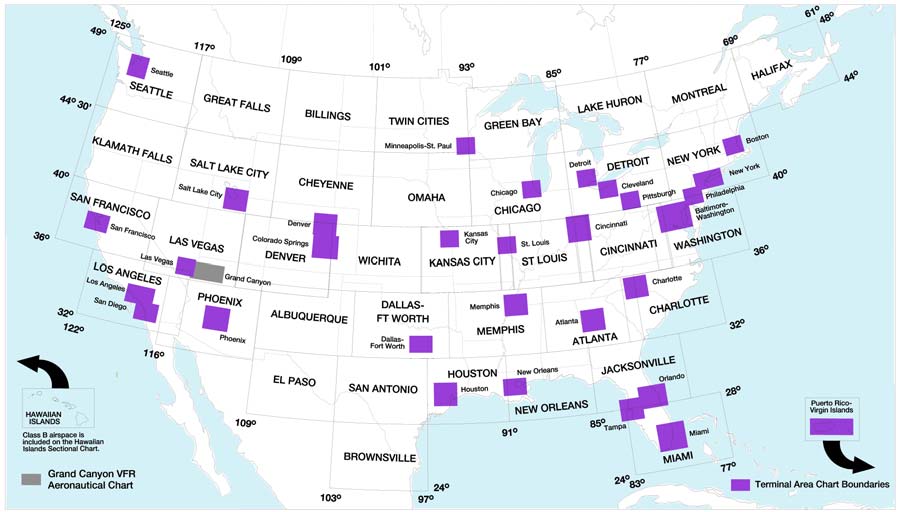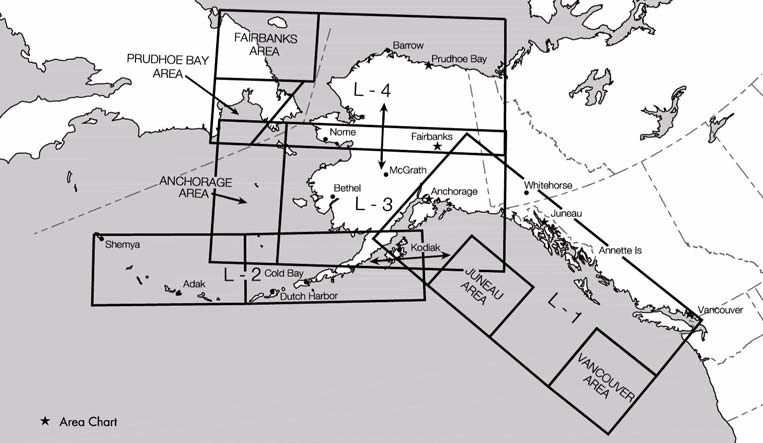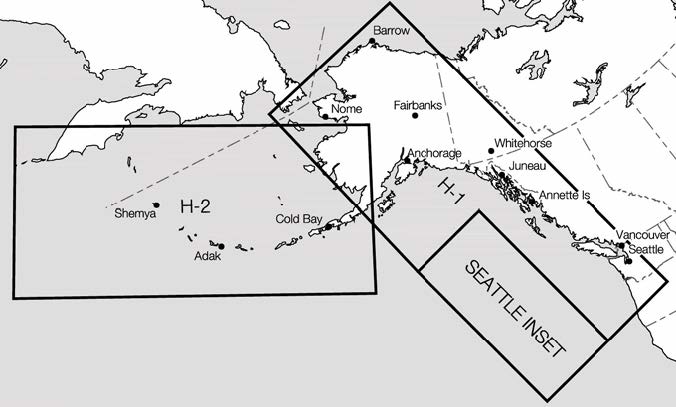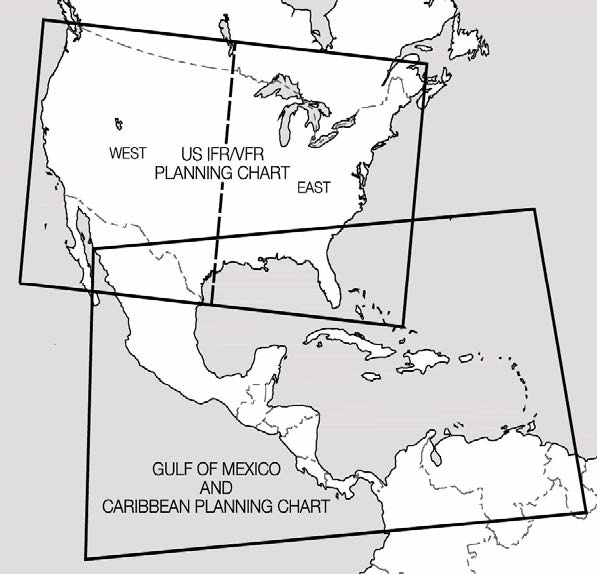Section 1. Types of Charts Available
-
General
Civil aeronautical charts for the U.S. and its territories, and possessions are produced by Aeronautical Information Services (AIS), https://www.faa.gov/air_traffic/flight_info/aeronav/safety_alerts/ which is part of FAA's Air Traffic Organization, Mission Support Services.
-
Obtaining Aeronautical Charts
Public sales of charts and publications are available through a network of FAA approved print providers. A listing of products, dates of latest editions and agents is available on the AIS website at: https://www.faa.gov/air_traffic/flight_info/aeronav/safety_alerts/.
-
Safety Alerts, Charting Notices, and Data Product Notices
- Safety Alerts (SAs) are published to notify users of an error that was reported or discovered in one of our digital products. The specific product and effective date(s) are provided.
- Charting Notices (CNs) are published to notify users of a planned chart/publication enhancement and the effective date on which the enhancement will be implemented.
- Data Product Notices (DPNs) are published to notify users of a system outage. DPNs may also be used to notify users of a developmental upgrade to one of our digital products and the effective date on which the upgrade will be implemented.
- A listing of these notices is found on the AIS website at: https://www.faa.gov/air_traffic/flight_info/aeronav/safety_alerts/.
-
Selected Charts and Products Available
VFR Navigation Charts
IFR Navigation Charts
Planning Charts
Supplementary Charts and Publications
Digital Products -
General Description of Each Chart Series
-
VFR Navigation Charts.
- Sectional Aeronautical Charts. Sectional Charts are designed for visual navigation of slow to medium speed aircraft. The topographic information consists of contour lines, shaded relief, drainage patterns, and an extensive selection of visual checkpoints and landmarks used for flight under VFR. Cultural features include cities and towns, roads, railroads, and other distinct landmarks. The aeronautical information includes visual and radio aids to navigation, airports, controlled airspace, special-use airspace, obstructions, and related data. Scale 1 inch = 6.86 nm/1:500,000. 60 x 20 inches folded to 5 x 10 inches. Revised every 56 days. (See FIG 9-1-1 and FIG 9-1-2.)
- VFR Terminal Area Charts (TAC). TACs depict the airspace designated as Class B airspace. While similar to sectional charts, TACs have more detail because the scale is larger. The TAC should be used by pilots intending to operate to or from airfields within or near Class B or Class C airspace. Areas with TAC coverage are indicated by a • on the Sectional Chart indexes. VFR Transition Routes may be depicted and/or described on this chart. Scale 1 inch = 3.43 nm/1:250,000. Revised every 56 days. (See FIG 9-1-1 and FIG 9-1-2.)
- U.S. Gulf Coast VFR Aeronautical Chart. The Gulf Coast Chart is designed primarily for helicopter operation in the Gulf of America area. Information depicted includes offshore mineral leasing areas and blocks, oil drilling platforms, and high density helicopter activity areas. Scale 1 inch = 13.7 nm/1:1,000,000. 55 x 27 inches folded to 5 x 10 inches. Revised every 56 days.
-
Grand Canyon VFR Aeronautical Chart. Covers the Grand Canyon National Park area and is designed to promote aviation safety, flight free zones, and facilitate VFR navigation in this popular area. The chart contains aeronautical information for general aviation VFR pilots on one side and commercial VFR air tour operators on the other side. Revised every 56 days.
FIG 9-1-1
Sectional and VFR Terminal Area Charts for the Conterminous U.S., Hawaii, Puerto Rico, and Virgin Islands

-
Caribbean VFR Aeronautical Charts. Caribbean 1 and 2 (CAC-1 and CAC-2) are designed for visual navigation to assist familiarization of foreign aeronautical and topographic information. The aeronautical information includes visual and radio aids to navigation, airports, controlled airspace, special-use airspace, obstructions, and related data. The topographic information consists of contour lines, shaded relief, drainage patterns, and a selection of landmarks used for flight under VFR. Cultural features include cities and towns, roads, railroads, and other distinct landmarks. Scale 1 inch = 13.7 nm/1:1,000,000. CAC-1 consists of two sides measuring 30” x 60” each. CAC-2 consists of two sides measuring 20” x 60” each. Revised every 56 days. (See FIG 9-1-3.)

-
Helicopter Route Charts. A three-color chart series which shows current aeronautical information useful to helicopter pilots navigating in areas with high concentrations of helicopter activity. Information depicted includes helicopter routes, four classes of heliports with associated frequency and lighting capabilities, NAVAIDs, and obstructions. In addition, pictorial symbols, roads, and easily identified geographical features are portrayed. Scale 1 inch = 1.71 nm/1:125,000. 34 x 30 inches folded to 5 x 10 inches. Revised every 56 days. (See FIG 9-1-4.)

-
IFR Navigation Charts.
-
IFR En Route Low Altitude Charts (Conterminous U.S. and Alaska). En route low altitude charts provide aeronautical information for navigation under IFR conditions below 18,000 feet MSL. This four-color chart series includes airways; limits of controlled airspace; VHF NAVAIDs with frequency, identification, channel, geographic coordinates; airports with terminal air/ground communications; minimum en route and obstruction clearance altitudes; airway distances; reporting points; special use airspace; and military training routes. Scales vary from 1 inch = 5nm to 1 inch = 20 nm. 50 x 20 inches folded to 5 x 10 inches. Charts revised every 56 days. Area charts show congested terminal areas at a large scale. They are included with subscriptions to any conterminous U.S. Set Low (Full set, East or West sets). (See FIG 9-1-5 and FIG 9-1-6.)


-
IFR En Route High Altitude Charts (Conterminous U.S. and Alaska). En route high altitude charts are designed for navigation at or above 18,000 feet MSL. This four-color chart series includes the jet route structure; VHF NAVAIDs with frequency, identification, channel, geographic coordinates; selected airports; reporting points. Scales vary from 1 inch = 45 nm to 1 inch = 18 nm. 55 x 20 inches folded to 5 x 10 inches. Revised every 56 days. (See FIG 9-1-7 and FIG 9-1-8.)


-
U.S. Terminal Procedures Publication (TPP). TPPs are published in 24 loose-leaf or perfect bound volumes covering the conterminous U.S., Puerto Rico and the Virgin Islands. A Change Notice is published at the midpoint between revisions in bound volume format and is available on the internet for free download at the AIS website. (See FIG 9-1-15.) The TPPs include:
- Instrument Approach Procedure (IAP) Charts. IAP charts portray the aeronautical data that is required to execute instrument approaches to airports. Each chart depicts the IAP, all related navigation data, communications information, and an airport sketch. Each procedure is designated for use with a specific electronic navigational aid, such as ILS, VOR, NDB, RNAV, etc.
- Instrument Departure Procedure (DP) Charts. DP charts are designed to expedite clearance delivery and to facilitate transition between takeoff and en route operations. They furnish pilots' departure routing clearance information in graphic and textual form.
- Standard Terminal Arrival (STAR) Charts. STAR charts are designed to expedite ATC arrival procedures and to facilitate transition between en route and instrument approach operations. They depict preplanned IFR ATC arrival procedures in graphic and textual form. Each STAR procedure is presented as a separate chart and may serve either a single airport or more than one airport in a given geographic area.
- Airport Diagrams. Full page airport diagrams are designed to assist in the movement of ground traffic at locations with complex runway/taxiway configurations and provide information for updating geodetic position navigational systems aboard aircraft. Airport diagrams are available for free download at the AIS website.
- Alaska Terminal Procedures Publication. This publication contains all terminal flight procedures for civil and military aviation in Alaska. Included are IAP charts, DP charts, STAR charts, airport diagrams, radar minimums, and supplementary support data such as IFR alternate minimums, take-off minimums, rate of descent tables, rate of climb tables and inoperative components tables. Volume is 5-3/8 x 8-1/4 inch top bound. Publication revised every 56 days with provisions for a Terminal Change Notice, as required.
-
IFR En Route Low Altitude Charts (Conterminous U.S. and Alaska). En route low altitude charts provide aeronautical information for navigation under IFR conditions below 18,000 feet MSL. This four-color chart series includes airways; limits of controlled airspace; VHF NAVAIDs with frequency, identification, channel, geographic coordinates; airports with terminal air/ground communications; minimum en route and obstruction clearance altitudes; airway distances; reporting points; special use airspace; and military training routes. Scales vary from 1 inch = 5nm to 1 inch = 20 nm. 50 x 20 inches folded to 5 x 10 inches. Charts revised every 56 days. Area charts show congested terminal areas at a large scale. They are included with subscriptions to any conterminous U.S. Set Low (Full set, East or West sets). (See FIG 9-1-5 and FIG 9-1-6.)
-
Planning Charts.
- U.S. IFR/VFR Low Altitude Planning Chart. This chart is designed for prefight and en route flight planning for IFR/VFR flights. Depiction includes low altitude airways and mileage, NAVAIDs, airports, special use airspace, cities, times zones, major drainage, a directory of airports with their airspace classification, and a mileage table showing great circle distances between major airports. Scale 1 inch = 47nm/1:3,400,000. Chart revised annually, and is available either folded or unfolded for wall mounting. (See FIG 9-1-10.)
- Gulf of America and Caribbean Planning Chart. This is a VFR planning chart on the reverse side of the Puerto Rico - Virgin Islands VFR Terminal Area Chart. Information shown includes mileage between airports of entry, a selection of special use airspace and a directory of airports with their available services. Scale 1 inch = 85nm/1:6,192,178. 60 x 20 inches folded to 5 x 10 inches. Revised every 56 days. (See FIG 9-1-10.)
-
Alaska VFR Wall Planning Chart. This chart is designed for VFR preflight planning and chart selection. It includes aeronautical and topographic information of the state of Alaska. The aeronautical information includes public and military airports; radio aids to navigation; and Class B, Class C, TRSA and special-use airspace. The topographic information includes city tint, populated places, principal roads, and shaded relief. Scale 1 inch = 27.4 nm/1:2,000,000. The one sided chart is 58.5 x 40.75 inches and is designed for wall mounting. Revised annually. (See FIG 9-1-9.)


-
U.S. VFR Wall Planning Chart. This chart is designed for VFR preflight planning and chart selection. It includes aeronautical and topographic information of the conterminous U.S. The aeronautical information includes airports, radio aids to navigation, Class B airspace and special use airspace. The topographic information includes city tint, populated places, principal roads, drainage patterns, and shaded relief. Scale 1 inch = 43 nm/ 1:3,100,000. The one-sided chart is 59 x 36 inches and ships unfolded for wall mounting. Revised annually. (See FIG 9-1-11.)

- VFR Flyway Planning Charts. This chart is printed on the reverse side of selected TAC charts. The coverage is the same as the associated TAC. Flyway planning charts depict flight paths and altitudes recommended for use to bypass high traffic areas. Ground references are provided as a guide for visual orientation. Flyway planning charts are designed for use in conjunction with TACs and sectional charts and are not to be used for navigation. VFR Transition Routes may be depicted and/or described on this chart. Chart scale 1 inch = 3.43 nm/1:250,000.
-
Supplementary Charts and Publications.
- Chart Supplement refers to a series of civil/military flight information publications issued by FAA every 56 days consisting of the Chart Supplement U.S., Chart Supplement Alaska, and Chart Supplement Pacific.
-
Chart Supplement U.S. This is a civil/military flight information publication. This 7-volume book series is designed for use with appropriate IFR or VFR charts and contains data including, but not limited to, airports, NAVAIDs, communications data, weather data sources, special notices, non-regulatory operational procedures, and airport diagrams. Coverage includes the conterminous U.S., Puerto Rico, and the Virgin Islands. The Chart Supplement U.S. shows data that cannot be readily depicted in graphic form; for example, airport hours of operations, types of fuel available, run widths, and lighting codes. (See FIG 9-1-12.)
FIG 9-1-12
Chart Supplement U.S. Geographic Areas
- Chart Supplement Alaska. This is a civil/military flight information publication. This single-volume book is designed for use with appropriate IFR or VFR charts. The Chart Supplement Alaska contains data including, but not limited to, airports, NAVAIDs, communications data, weather data sources, special notices, non-regulatory operational procedures, and airport diagrams. The publication also includes uniquely geographical operational requirements as area notices and emergency procedures.
- Chart Supplement Pacific. This is a civil/military flight information publication. This single volume book is designed for use with appropriate IFR or VFR charts. The Chart Supplement Pacific contains data including, but not limited to, airports, NAVAIDs, communications data, weather data sources, special notices, non-regulatory operational procedures, and airport diagrams. The publication also includes airspace, navigational facilities, non-regulatory Pacific area procedures, Instrument Approach Procedures (IAP), Departure Procedures (DP), Standard Terminal Arrival (STAR) charts, radar minimums, supporting data for the Hawaiian and Pacific Islands, and uniquely geographical operational requirements as area notices and emergency procedures.
-
North Atlantic Route Chart. Designed for FAA controllers to monitor transatlantic flights, this 5-color chart shows oceanic control areas, coastal navigation aids, oceanic reporting points, and NAVAID geographic coordinates. Full Size Chart: Scale 1 inch = 113.1 nm/1:8,250,000. Chart is shipped flat only. Half Size Chart: Scale 1 inch = 150.8 nm/1:11,000,000. Chart is 29-3/4 x 20-1/2 inches, shipped folded to 5 x 10 inches only. Chart revised every 56 days. (See FIG 9-1-13.)

-
North Pacific Route Charts. These charts are designed for FAA controllers to monitor transoceanic flights. They show established intercontinental air routes, including reporting points with geographic positions. Composite Chart: Scale 1 inch = 164 nm/1:12,000,000. 48 x 41-1/2 inches. Area Charts: Scale 1 inch = 95.9 nm/1:7,000,000. 52 x 40-1/2 inches. All charts shipped unfolded. Charts revised every 56 days. (See FIG 9-1-14.)

- Airport Obstruction Charts (OC). The OC is a 1:12,000 scale graphic depicting 14 CFR part 77, Objects Affecting Navigable Airspace, surfaces, a representation of objects that penetrate these surfaces, aircraft movement and apron areas, navigational aids, prominent airport buildings, and a selection of roads and other planimetric detail in the airport vicinity. Also included are tabulations of runway and other operational data.
- FAA Aeronautical Chart User's Guide. A booklet designed to be used as a teaching aid and reference document. It describes the substantial amount of information provided on FAA's aeronautical charts and publications. It includes explanations and illustrations of chart terms and symbols organized by chart type. The users guide is available for free download at the AIS website.
-
Digital Products.
-
The Digital Aeronautical Information CD (DAICD). The DAICD is a combination of the NAVAID Digital Data File, the Digital Chart Supplement, and the Digital Obstacle File on one Compact Disk. These three digital products are no longer sold separately. The files are updated every 56 days and are available by subscription only.
- The NAVAID Digital Data File. This file contains a current listing of NAVAIDs that are compatible with the National Airspace System. This file contains all NAVAIDs including ILS and its components, in the U.S., Puerto Rico, and the Virgin Islands plus bordering facilities in Canada, Mexico, and the Atlantic and Pacific areas.
- The Digital Obstacle File. This file describes all obstacles of interest to aviation users in the U.S., with limited coverage of the Pacific, Caribbean, Canada, and Mexico. The obstacles are assigned unique numerical identifiers, accuracy codes, and listed in order of ascending latitude within each state or area.
- The Coded Instrument Flight Procedures (CIFP) (ARINC 424 [Ver 13 & 15]). The CIFP is a basic digital dataset, modeled to an international standard, which can be used as a basis to support GPS navigation. Initial data elements included are: Airport and Helicopter Records, VHF and NDB Navigation aids, en route waypoints and airways. Additional data elements will be added in subsequent releases to include: departure procedures, standard terminal arrivals, and GPS/RNAV instrument approach procedures. The database is updated every 28 days. The data is available by subscription only and is distributed on CD-ROM or by ftp download.
-
digital-Visual Charts (d-VC). These digital VFR charts are geo-referenced images of FAA Sectional Aeronautical, TAC, and Helicopter Route charts. Additional digital data may easily be overlaid on the raster image using commonly available Geographic Information System software. Data such as weather, temporary flight restrictions, obstacles, or other geospatial data can be combined with d-VC data to support a variety of needs. The file resolution is 300 dots per inch and the data is 8-bit color. The data is provided as a GeoTIFF and distributed on DVD-R media and on the AIS website. The root mean square error of the transformation will not exceed two pixels. Digital-VCs are updated every 56 days and are available by subscription only.

-
The Digital Aeronautical Information CD (DAICD). The DAICD is a combination of the NAVAID Digital Data File, the Digital Chart Supplement, and the Digital Obstacle File on one Compact Disk. These three digital products are no longer sold separately. The files are updated every 56 days and are available by subscription only.
-
VFR Navigation Charts.
-
Where and How to Get Charts of Foreign Areas
-
National Geospatial-Intelligence Agency (NGA) Products. For the latest information regarding publication availability visit the NGA website: https://www.nga.mil/ProductsServices/Pages/default.aspx.
-
Flight Information Publication (FLIP) Planning Documents.
General Planning (GP) Area Planning Area Planning Special Use Airspace Planning Charts -
FLIP En Route Charts and Chart Supplements.
Pacific, Australasia, and Antarctica U.S. - IFR and VFR Supplements Flight Information Handbook Caribbean and South America - Low Altitude Caribbean and South America - High Altitude Europe, North Africa, and Middle East - Low Altitude Europe, North Africa, and Middle East High Altitude Africa Eastern Europe and Asia Area Arrival Charts -
FLIP Instrument Approach Procedures (IAPs).
Africa
Canada and North Atlantic
Caribbean and South America
Eastern Europe and Asia
Europe, North Africa, and Middle East
Pacific, Australasia, and Antarctica
VFR Arrival/Departure Routes - Europe and Korea
U.S. -
Miscellaneous DoD Charts and Products.
Aeronautical Chart Updating Manual (CHUM)
DoD Weather Plotting Charts (WPC)
Tactical Pilotage Charts (TPC)
Operational Navigation Charts (ONC)
Global Navigation and Planning Charts (GNC)
Jet Navigation Charts (JNC) and Universal Jet Navigation Charts (JNU)
Jet Navigation Charts (JNCA)
Aerospace Planning Charts (ASC)
Oceanic Planning Charts (OPC)
Joint Operations Graphics - Air (JOG-A)
Standard Index Charts (SIC)
Universal Plotting Sheet (VP-OS)
Sight Reduction Tables for Air Navigation (PUB249)
Plotting Sheets (VP-30)
Dial-Up Electronic CHUM
-
Flight Information Publication (FLIP) Planning Documents.
-
Canadian Charts. Information on available Canadian charts and publications may be obtained by contacting the:
NAV CANADA
Aeronautical Publications
Sales and Distribution Unit
P.O. Box 9840, Station T
Ottawa, Ontario K1G 6S8 Canada
Telephone: 613-744-6393 or 1-866-731-7827
Fax: 613-744-7120 or 1-866-740-9992 -
Mexican Charts. Information on available Mexican charts and publications may be obtained by contacting:
Dirección de Navigacion Aereo
Blvd. Puerto Aereo 485
Zona Federal Del Aeropuerto Int'l
15620 Mexico D.F.
Mexico - International Civil Aviation Organization (ICAO). A list of free ICAO publications and catalogs is available at the following website: https://www.icao.int/publications/Pages/default.aspx.
-
National Geospatial-Intelligence Agency (NGA) Products. For the latest information regarding publication availability visit the NGA website: https://www.nga.mil/ProductsServices/Pages/default.aspx.